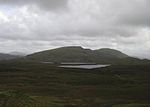Rhiwbach quarry
1 ft 11½ in gauge railways in WalesBro MachnoFfestiniog RailwayIndustrial railways in WalesSlate mines in Conwy County Borough ... and 1 more
Use British English from October 2017

Rhiwbach quarry (also known as Rhiw-bach quarry) was a slate quarry located to the east of Blaenau Ffestiniog in North Wales. The quarry was a remote site; it was nearly 4 miles (6.4 km) to north-east of Duffws, the Festiniog Railway's terminus in Blaenau Ffestiniog. It was the connected to the Ffestiniog Railway by the Rhiwbach Tramway. Commercial operation began around 1812, and it finally closed in 1952. It was the last Welsh slate quarry where workers lived in barracks on the site. 'Rhiwbach' is Welsh for 'Little Hill'.
Excerpt from the Wikipedia article Rhiwbach quarry (License: CC BY-SA 3.0, Authors, Images).Rhiwbach quarry
Quarry Incline,
Geographical coordinates (GPS) Address Nearby Places Show on map
Geographical coordinates (GPS)
| Latitude | Longitude |
|---|---|
| N 52.9977 ° | E -3.8799 ° |
Address
Quarry Incline
LL24 0RY , Bro Machno
Wales, United Kingdom
Open on Google Maps











